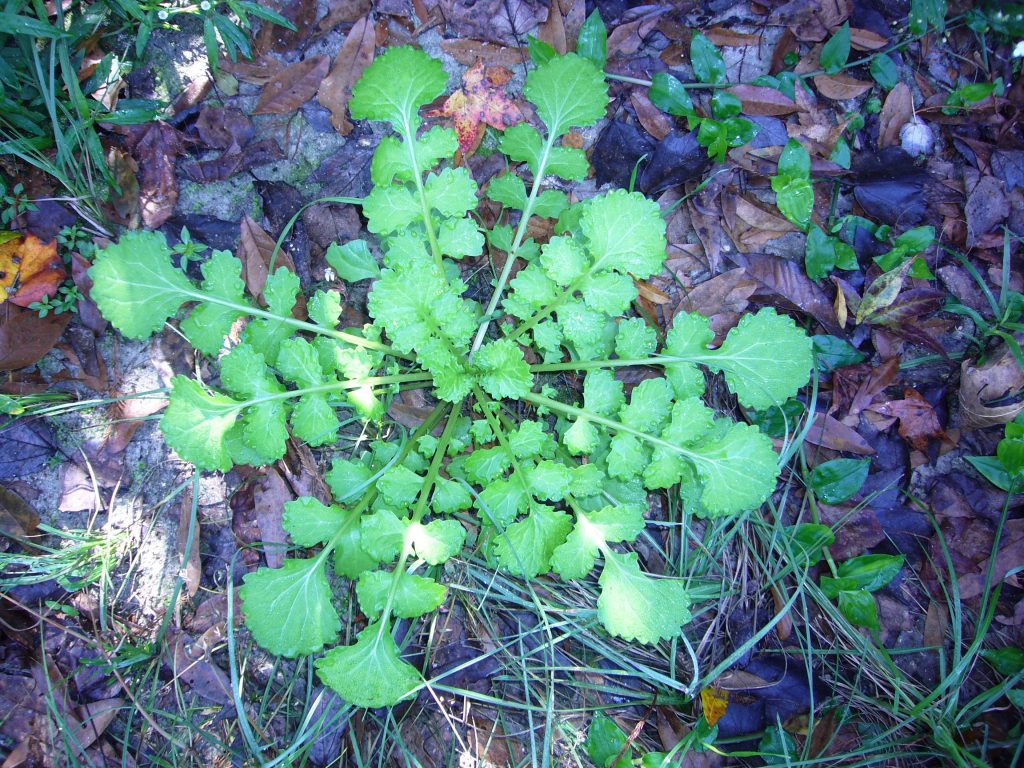
Toxic young Butterweed can make one think of mustards. Photo By Green Deane
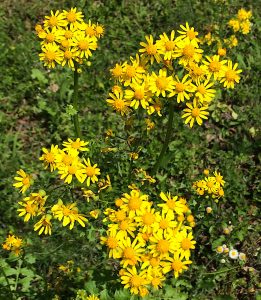
Butterweed’s blossom does not resemble a mustard. Photo by Green Deane
It’s time for my annual warning about Butterweed. It’s a toxic plant this time of year that’s been out for a while but seems to be flushing now. I learned it as Senecio glabellus but now some are calling it Packera glabella. This plant can put you in the hospital with serious liver damage. It is not on par with deadly mushroom but it’s down the same sickening road. There was a case in Southwest Florida just a few years ago. From a forager’s point of view it can — from a distance — resemble wild mustard or wild radish. On closer inspection it clearly is not a mustard. The blossoms are not a yellow cross and the leaves are not sandpappery. Growing in wet spots, Butterweed delivers its load of alkaloid pyrrolizidines without warning. Most alkaloids are bitter. Butterweed leaves are very mild in flavor and have a pleasing texture. Mustards do not. It’s in the Aster family which is 1) huge with some 22,000 members, and 2) plants in that family usually are not toxic. You can read more about pyrrolizidines here.
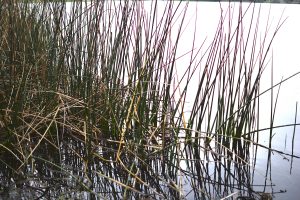
Bulrushes have edible roots. Photo by Green Deane
An often overlooked wild edible is Bulrush, which we saw this past weekend in Sarasota. This tall sedge gets second billing to the another common watery inhabitant, cattails. While there are several species of Bulrush locally the two one sees most often are Scirpus californicus and S. validus. Used like cattails, the easiest way to tell the species of Bulbrushes apart is to look at the seed tufts location and color of the seeds which introduces an important point: The experts tell us there are no toxic sedge seeds thus if you have a sedge you have a source of edible seeds. On these species the seeds are small but are easy to harvest (if you have a boat or a canoe.) To read more about Bulrushes and to identify sedges in general go here.

Foraging classes are held rain or shine, heat or cold. Photo by Nermina Krenata.
It will be Chamber of Commerce weather this weekend for my two foraging classes, 70s in the days, 50s at night (which is summertime weather in my native Maine.) Saturday is in Gainesville, Sunday a repeat in Largo.
Saturday, February 15th, Boulware Springs Park, 3420 SE 15th St., Gainesville, FL 32641. Meet at the picnic tables next to the pump house. 9 a.m. to noon.
Sunday, February 16th, Eagle Park Lake, 1800 Keene Road, Largo, FL 33771. Meet at the pavilion near the dog park. 9 a.m to noon. (This is to make up for an earlier class here that has scheduling issues.)
Sunday, February 23rd, John Chestnut County Park: 2200 East Lake Road, Palm Harbor, FL 34685. Meet at the trail head of the Peggy Park Nature Walk, pavilion 1 parking lot. 9 a.m. to noon.
Saturday, March 7th, Blanchard Park, 10501 Jay Blanchard Trail, Orlando, FL 32817. 9 a.m. to noon. Meet at the pavilion near the YMCA building and tennis courts.
Sunday, March 8th, George LeStrange Preserve, 4911 Ralls Road, Fort Pierce, FL, 34981. 9 a.m. to noon. (There are no official bathrooms at this location.)
Saturday, March 28th, Haulover Canal, Merritt Island National Refuge, north of the Kennedy Space Center. 9 a.m. to noon. Read the instructions below. We meet the the northwest end of the canal area.
Sunday, March 29th, Spruce Creek Park, 6250 Ridgewood Ave. Port Orange FL, meet at the pavilion. 9 a.m. to noon.
For more information, to sign up for a class or to pre-pay go here.
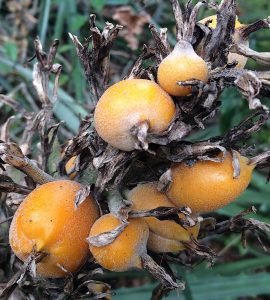
Wild Pineapple fruit ripen to golden and are soft. Photo by Green Deane
One of the odd things you can do in Florida is see plants that don’t exist. They are species the state has not collected samples of for official herbarium purposes thus they don’t officially exist. One of the non-existent plants you might be seeing this time of year is Wild Pineapple, Bromelia pinguin. I discovered it one Christmas Day some thirteen years ago and look forward to its brilliant blossoming and yellow fruit. I have since found it in several location although it is officially not anywhere. And be forewarned: Should you find this plant that does not exist it is is well-armed with spines that curve in both directions so it gets you coming and going. Also it’s edibility varies person to person so caution is advised as well. If I eat it I can’t taste anything for a few hours. Others eat the fruit without issue. To read more about the Wild Pineapple go here.
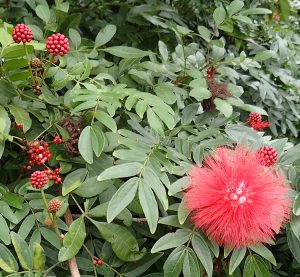
Calliandra haematocephala, the red powder puff. Photo by Green Deane
A common flowering ornamental one sees this time of year fi we’ve had some warm interludes is Calliandra haematocephala. It’s a powder puffy shrub that’s native of Malaysia or maybe Bolivia, not exactly close countries. Called the “Red Powder Puff” it’s a small tree that was in the pea family but has been moved to the Mimosa group. As far as I can tell, it’s not edible in any way just pretty which has its own value. The name is slightly interesting in that it is all living Greek mangled by Dead Latin. Calliandra is a combination of Kallos (beautiful) and Andros (man) but is to mean — when poetically translated — “pretty stamen” (the male part of the flower which creates the powder puff.) Haematocephala means “blood head” or in this case “red head.” Thus “beautiful man blood head” or pretty “stamen red head.” You could even stretch it to “pretty redheaded man.”

Foraging DVDs make a good gift to watch during the lifeless months of winter.
Though your foraging may drop off during the winter it’s a great time to study wild edibles with my nine DVD set. Each DVDs has 15 videos for 135 in all. They make a great gift. Order today. Some of these videos are of better quality than my free ones on the Internet. They are the same videos but many people like to have their own copy. I burn and compile the sets myself so if you have any issues I handle them personally. There are no middle foragers. And I’m working on adding a tenth DVD. To learn more about the DVDs or to order them click here.
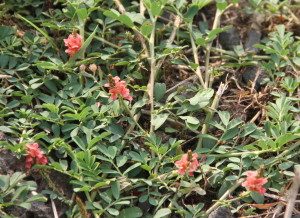
Indigofera spicata, Creeping Indigo, is toxic to horses and has caused death locally. Not edible.
Veterinarians have also issued their annual warning about a plant that is makes horses sick locally, Creeping Indigo, Indigofera spicata. Cold weather causes this pea relative to blossom pink, making it a little easier to see. Unfortunately it is a plant favored by horses with at least one dying and others sickened. (This highlights that relying on instinctual means to avoid toxic plants is not too reliable for animals or man.) As with many toxic and invasive species Creeping Indigo was intentionally brought to Florida in 1925. The University of Florida imported it from Sri Lanka (then Ceylon) for agricultural experiments. When it killed one of two rabbits the testing stopped but the weed stayed (the second rabbit recovered after the Creeping Indigo was removed from its diet.) Within eight years Creeping Indigo was raising concerns about poisoning farm animals.
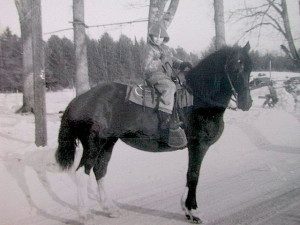
Green Deane as a sprout on Ginger (who in real life was a Boss Horse called Dinny.”
Besides horses, it is also toxic to cattle, sheep, goats, guinea pigs, rabbits, and birds. Pigs won’t eat it which calls into question reports that it does not bother pigs. Someone might be assuming that since pigs aren’t being reported sick from eating Creeping Indigo they aren’t bothered by it whereas it could equally be that because pigs avoid it there are no reports porcine poisoning. The prime toxin in Indigofera spicata is indospicine which “inhibits the incorporation of arginine and other amino acids in liver cells result in liver insufficiency.” I follow animal poisoning because I grew with a farm menagerie that included several horses, dogs, cats. chickens, ducks, rabbits and squirrels.

Green Deane Forum
Want to identify a plant? Perhaps you’re looking for a foraging reference? You might have a UFO, an Unidentified Flowering Object, you want identified. On the Green Deane Forum we — including Green Deane and others from around the world — chat about foraging all year. And it’s not just about warm-weather plants or just North American flora. Many nations share common weeds so there’s a lot to talk. There’s also more than weeds. The reference section has information for foraging around the world. There are also articles on food preservation, and forgotten skills from making bows to fermenting food.
This is weekly newsletter 392, If you want to subscribe to this free newsletter you can find the sign-up form in the menu at the top of the page.
To donate to the Green Deane Newsletter click here.


Hi…could you please tell me if I can make tea from my scarlet flame passion vine?? I know you can make it with the purple flower…please advise
I wouldn’t. All Passifloras have some cyanide in their leaves except Passiflora incarnata.